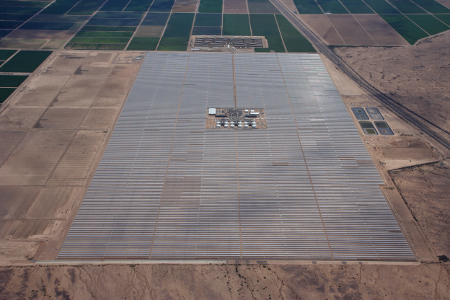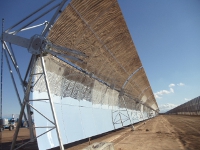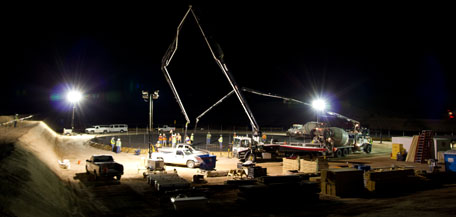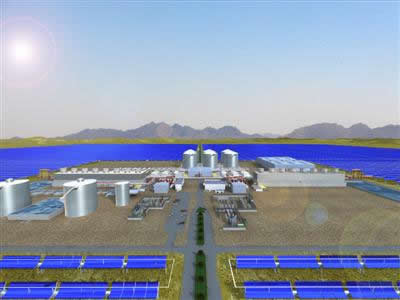
October 2013.
Abengoa (MCE: ABG.B), the international company that applies innovative technology solutions for sustainability in the energy and environment sectors, has announced that Solana, the world´s largest parabolic trough plant with a total installed capacity of 280 MW (gross) and also the first solar plant in the United States with thermal energy storage, has successfully passed commercial operation tests. This milestone marks a major accomplishment for Abengoa and the Concentrating Solar Power (CSP) industry.
Solana is the first solar plant in the U.S. with a thermal energy storage system that is able to generate electricity for six hours without the concurrent use of the solar field, which is a turning point for renewable energy in this country, being a tangible demonstration that solar energy can be stored and dispatched upon demand.
Solana, located near Gila Bend and about 70 miles southwest of Phoenix, Arizona, began construction in 2010 and on Monday, October 7, successfully fulfilled production forecasts required to date and testing for commercial operation. These tests included operating at the turbine’s full capacity while charging the thermal storage system, continuing to produce electricity after the sun went down, and starting up the plant and producing 6 hours of electricity using only the thermal storage system. These tests successfully demonstrated the various operation modes of the plant’s operation.
Abengoa’s first utility-scale solar plant in the United States employs parabolic trough technology. This technology consists of parabolic shaped mirrors mounted on structures that track the sun and concentrate the sun’s heat, later transforming water into steam and powering a conventional steam turbine. This mature technology has additional value since the heat can also be stored and used to produce clean electricity after the sun goes down or during a transitory period.
This ability to generate electricity when needed, or dispatchability, is one of the unique characteristics of concentrating solar power versus other types of renewables. Solana’s thermal storage system, without the use of the solar field, can produce clean energy for six hours at maximum power. These six hours will satisfy Arizona’s peak electricity demands during the summer evenings and early night time hours. Dispatchability also eliminates intermittency issues that other renewables, such as wind and photovoltaics, contend with, providing stability to the grid and thus increasing the value of the energy generated by CSP.
Arizona Public Service (APS), the largest utility in Arizona, will purchase all of the electricity produced by the solar plant for 30 years through a power purchase agreement with Abengoa.
Solana will generate the clean energy equivalent to that needed to power 70,000 households and will prevent about half a million tons of CO2 from being emitted into the atmosphere per year. The construction of Solana led to the creation of more than 2,000 jobs and a national supply chain that spans 165 companies in 29 states.
The total investment of the plant is approximately two billion dollars and during financing, Solana received a federal loan guarantee for $1.45 billion from the United States Department of Energy Federal Loan Guarantee Program. This support made the construction of Solana possible, creating or maintaining thousands of jobs both in the building of the plant as well as those direct and indirect jobs in the supply chain, as well as providing the Southwest with clean, sustainable energy using innovative technology.
Abengoa currently has 1,223 MW of concentrating solar power in operation and 430 MW under construction. It is the largest CSP company in the world and one of the few that constructs and operates both solar tower and parabolic trough plants.

Download image (high resolution)
October 2013.
Abengoa (MCE: ABG.B), the international company that applies innovative technology solutions for sustainability in the energy and environment sectors, has added Liberty Interactive Corporation (“Liberty”) (Nasdaq: LINTA, LINTB, LVNTA, LVNTB) as an investor in Solana, the largest parabolic trough solar plant in the world. Solana, which is in its final testing phase, has a total installed capacity of 280 MW (gross) and will be the first solar plant in the United States with thermal energy storage. During these final tests, the concentrating solar power (CSP) plant is demonstrating that it will generate electricity during the day and night, and its capacity to store energy and adapt to consumption demands.
Liberty’s $300 million investment in the limited liability company that holds Solana has been approved by the U.S. Department of Energy (DOE) and the Federal Energy Regulatory Commission (FERC). Abengoa will continue as managing partner and will be responsible for the management, operation and maintenance of the plant. The total investment in the plant is approximately $2 billion and during financing, received a federal loan guarantee for $1.45 billion. Liberty’s investment is attributed to its Liberty Ventures Group.
One of the advantages of CSP over other renewables is its ability to store energy efficiently. The thermal storage system makes the energy generated dispatchable, permitting plant operation during transient periods or after sundown. This dispatchability eliminates the intermittency that other renewables, like wind or photovoltaics, experience and thus the electricity generated from CSP plants has a higher value.
Solana is located near Gila Bend, Arizona. Parabolic trough technology is a mature technology that enables clean energy to be produced and stored. Solana’s thermal energy storage system has the capacity to store energy for 6 hours at maximum power, which will allow the plant to generate dispatchable electricity throughout the day and night. The six hours of storage will be able to satisfy the region’s peak electricity demands during the summer evenings and early night time hours.
Arizona Public Service (APS), the largest utility in Arizona, will purchase all of the electricity produced by the solar plant through a power purchase agreement with Solana.
Solana will generate the clean energy equivalent to that needed to power 70,000 households and will prevent about half a million tCO2 from being emitted into the atmosphere per year. Also, Solana has reduced water consumption to less than 25 percent of that consumed when the land was previously used for agricultural purposes. These reductions will help reach state renewable energy goals, as well as reach the U.S. national goals for climate change mitigation.
Furthermore, the construction of Solana, which began in 2010, led to the creation of more than 2,000 jobs and a national supply chain that spans 165 companies in 29 states.
Abengoa currently has 931 MW of CSP in operation and 710 MW under construction. It is the largest CSP company in the world and one of the few that constructs and operates both solar tower and parabolic trough plants.
November 2012.
Abengoa (MCE: ABG), the international company that applies innovative technology solutions for sustainable development in the energy and environment sectors, announced that the construction of Solana, located about 70 miles southwest of Phoenix, Arizona, is 80 % complete. The project’s construction began in December 2010 and the plant is planned to start operation in the summer of 2013.
Solana, one of the world´s largest plants, once finished, will have the installed capacity of 280 MW (gross) using the parabolic trough technology and six hours of thermal energy storage. This will allow the plant to produce and supply electricity even during cloudy periods or after sunset, meeting the peak demand of this region during the summer months. Its solar field will be composed by 32,000 collectors.
Abengoa has estimated that the development of this project is creating more than 2000 construction jobs, as well as the approximated 85 employees that will be needed to operate the plant. With numerous indirect jobs that have been generated by this project in the area, Abengoa’s initial job creation predictions have been exceeded.
The supply chain for Solana spans 27 states from coast to coast, including Kentucky, Kansas, Louisiana, Missouri, New York and Oregon with contracts signed with 90 companies. As a result, a new workforce is being trained that will contribute to the needed cost reductions in an industry that contributes to keeping the United States competitive in the twenty-first century.
From the environmental perspective, Solana will produce clean electricity to power the equivalent of 70,000 homes and will reduce CO2 emissions by around 475,000 tons for each year. These reductions will help reach state renewable energy goals, as well as reaching the national goals of United States for climate change mitigation.
Abengoa received a federal loan guarantee, through the Department of Energy (DOE) for $1.45 billion that facilitated the financial close with the Federal Financing Bank (FFB) and to begin the plant’s construction.
Abengoa is constructing three similar projects, one in the United States, specifically the Mojave Desert, and two in the Northern Cape province of South Africa. With a total of 743 MW in operation and 910 MW in construction, it is one of the few companies in the world that builds and operates concentrating solar power plants using both the tower and parabolic trough technologies.
April 2012.
Abengoa (MCE: ABG), the international company that applies innovative technology solutions for sustainable development in the energy and environment sectors, has announced that it will collaborate with Capital Riesgo Global, a subsidiary of Banco Santander, which will become a financial partner in the development of Solana, the largest concentrating solar power plant in the world. The plant, which is currently being built by Abengoa in Arizona, will have a production capacity of 280 MW gross and will be the first solar plant in the United States with the ability to store energy.
Capital Riesgo Global will invest $125 million in exchange for an equity stake in the project. The total investment for Solana is around $2,000 million. Abengoa obtained a federal loan guarantee for approximately $1.45 billion in December 2010 from the U.S. Department of Energy (DOE) Loan Programs Office to finance this project. This investment, which has been approved by the U.S. Department of Energy and the Federal Energy Regulatory Commission (FERC), will reduce Abengoa’s own capital requirement contribution and is fully compatible with the potential entry of a tax equity investor in the project.
Solana is the first large-scale plant to be developed by Abengoa in Arizona. With a capacity of 280 MW gross, it will be the largest concentrating solar power plant in the world. Concentrating solar power is a mature technology that, due to thermal inertia and storage, allows the plant to produce dispatchable electricity throughout the day, averting intermittency that other renewables experience, such as wind and photovoltaics. The plant was recently visited by the United States Secretary of the Interior, Ken Salazar. Construction work is on track to begin producing energy by summer 2013, having achieved almost 50 percent of progress in construction so far. The project has already created more than 1,300 direct jobs and will soon reach 1,600. Solana will generate enough energy to supply 70,000 households and will prevent the emission of 475,000 tons of CO2 per annum.
Abengoa currently has more than 1 GW of solar capacity under construction around the world. It also has a total of 543 MW in operation and is the only company in the world to construct and operate concentrating solar power plants using both tower and parabolic trough technologies.

Installation of some of the parabolic trough mirrors at Solana
February 2012.
Development of the 280 MW Solana CSP plant continues and it will become one of the world’s largest solar power plants in 2013. Solana will feature a storage system that will allow it to produce electricity during cloudy periods and after sunset.
The plant, under construction for the past year in Gila Bend, Arizona, has created some 780 jobs to date. Abengoa Solar expects this figure to increase to around the 1,600 workers required to install the 3,232 parabolic trough collectors and approximately 900,000 mirrors that will form the plant’s 7.8 km2 solar field.
The Solana project is contributing to the economic development of the region thanks to the need for materials and services to enable construction. There are already 30 companies from 22 states in the supply chain and this number will continue to grow as work progresses.
These suppliers are providing important equipment and materials for the project, including the cooling systems, power transmission lines, piping, mirrors and receivers. The company expects the number of contracts to suppliers to increase by about 50 more prior to completion of construction, and it estimates that over 70 % of the products and services required will be of United States origin.
Many of these companies have opened factories in other states and have boosted their workforces since they began to work with Abengoa Solar.
Thus, not only will Solana help to produce clean energy and reduce greenhouse gas emissions, it is already providing financial benefits directly related to the local community, and extending throughout the country.
http://www.abengoa.com/htmlsites/boletines/en/febrero2012/infraestructuras/
September 2011.
Solana, the 280 MW solar power plant under construction, is located close to Phoenix, Arizona (US). It will incorporate a thermal storage system that will allow it to continue operating for up to six hours after sunset or during overcast periods, producing energy equivalent to the consumption needs of 70,000 homes.
Moreover, not only will it provide business and economic benefits, it also affords numerous social and environmental improvements. Since construction commenced in December 2010, its positive influence on the economy has been notable. Up to now, some 300 jobs have been created and the creation of a further 1,300 is foreseen before construction is completed. When it comes into commercial operation, between 85 and 100 qualified workers will join the project.
From an environmental perspective, Solana will afford Arizona clean energy, pollution and greenhouse gas emissions free, reducing the use of fossil fuels and avoiding the yearly emission of almost half a M tons of CO2. Solana will lead towards the creation of a green economy in the United States.

Construction of Solana
http://www.abengoa.com/htmlsites/boletines/en/septiembre2011/infraestructuras/
February 2011.
Abengoa Solar announced a $1,450 M financial closure for construction and start-up of the world’s largest solar thermal power plant – Solana – a 250 MW solar thermal plant to be built in Arizona (US).
The United States Department of Energy has awarded, through its loan assurance office, a federal guarantee on credit given to support this project. Moreover, the Solana project, on which construction has already commenced, meets the requirements established in program 1603 sponsored by the United States Treasury Department, which will enable the project to benefit from a grant amounting to 30 % of the total cost of the investment.
The plant will be located 100 kilometers southwest of Phoenix and will produce sufficient energy to cover the consumption needs of 70,000 homes while avoiding the emission of 475,000 tons of CO2 per year, compared with a natural gas plant. Moreover, it will generate significant economic and environmental benefits for Arizona State, helping to achieve the objectives of national energy independence.
Solana is the first solar power plant in the US that is capable of storing the energy it produces, six hours of thermal energy storage utilizing molten salts that will allow electricity to be produced during overcast periods and after sunset. The plant will produce energy at night to satisfy the demand for electricity that exists in the area in summertime.
Abengoa Solar estimates the Solana project will generate from 1,600 to 1,700 jobs during construction, and 85 permanent jobs. Furthermore, about 75 % of the equipment and supplies required for its construction will be manufactured in the US.

http://www.abengoa.com/htmlsites/boletines/en/febrero2011/dia.html